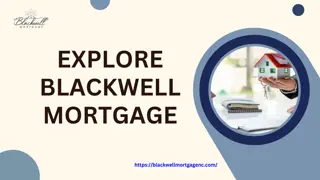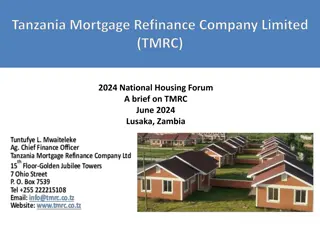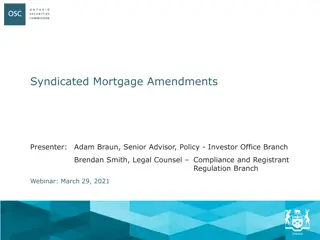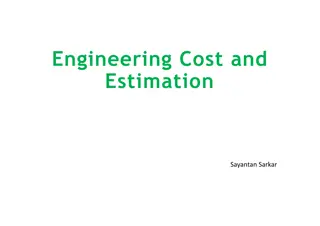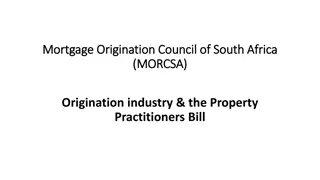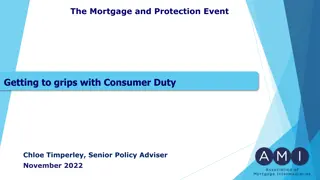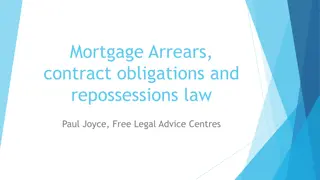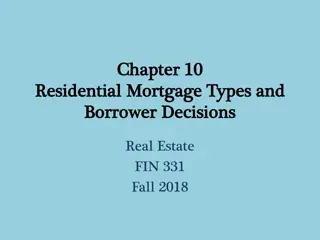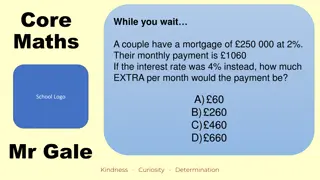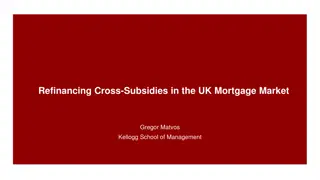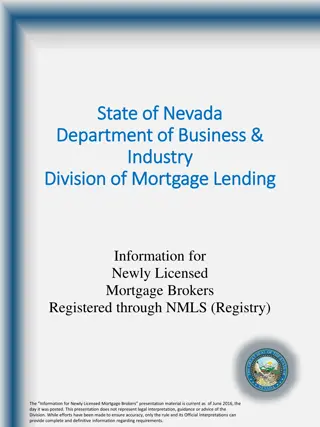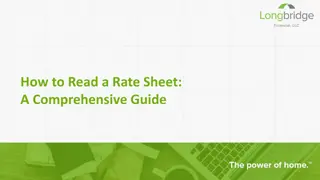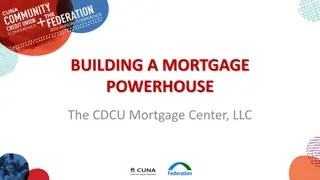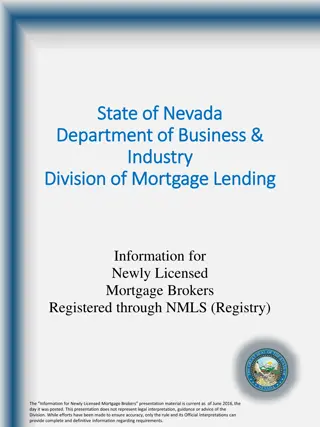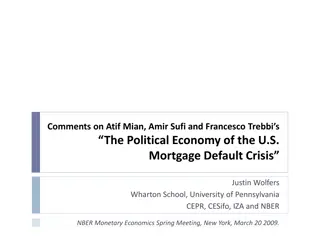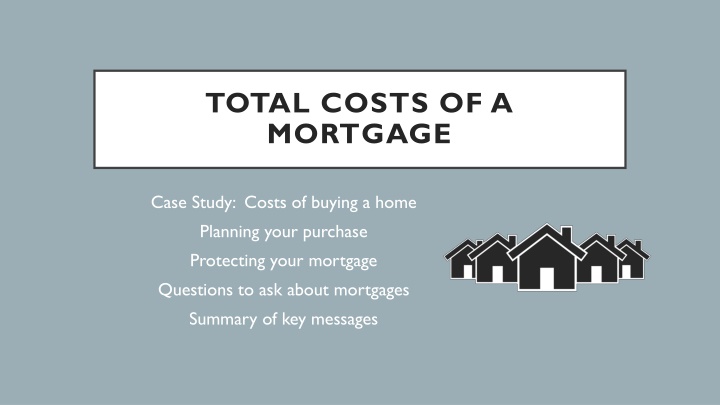
The Total Costs of a Mortgage - Case Study on Home Buying
Explore the costs of buying a home, managing a mortgage, and essential questions to ask before committing. Follow the case study of Francis and Angela as they navigate the financial aspects of purchasing a new home and learn valuable insights for a successful home buying journey.
Download Presentation

Please find below an Image/Link to download the presentation.
The content on the website is provided AS IS for your information and personal use only. It may not be sold, licensed, or shared on other websites without obtaining consent from the author. If you encounter any issues during the download, it is possible that the publisher has removed the file from their server.
You are allowed to download the files provided on this website for personal or commercial use, subject to the condition that they are used lawfully. All files are the property of their respective owners.
The content on the website is provided AS IS for your information and personal use only. It may not be sold, licensed, or shared on other websites without obtaining consent from the author.
E N D
Presentation Transcript
TOTAL COSTS OF A MORTGAGE Case Study: Costs of buying a home Planning your purchase Protecting your mortgage Questions to ask about mortgages Summary of key messages
INTRODUCTION When you're planning to buy a home, don't forget that there's more to it than just the purchase price. Not only are there the many costs associated with buying, financing and transferring a home, but there are also the costs of setting up a new residence and the ongoing costs of running a household. To be able to enjoy your home, you have to be able to manage the total costs comfortably.
INTRODUCTION You will explore: The costs of buying and maintaining a home in addition to the costs of a mortgage How to protect your finances with mortgage insurance What you need to think about before buying a home and taking on a mortgage. You'll use a worksheet to plan for the full costs of buying a new home with a mortgage loan. You'll answer the questions you need to ask yourself before taking on a mortgage, and the questions to ask a mortgage lender. By the time you finish this section, you'll be able to plan for the costs of a mortgage and choose one that best suits your needs.
CASE STUDY: COSTS OF BUYING A HOME Francis and Angela knew that buying a new home was a big financial commitment, but they'd been saving for a year, and with their parents' help they had $30,000 they could spend. The house they wanted would cost $225,000, and they wanted to renovate the kitchen and bathrooms to make them more modern.
CASE STUDY: COSTS OF BUYING A HOME "The down payment on the mortgage, including mortgage insurance, is over $17,000," Angela said, "and all the fees will be another $4,500 at least." "$4,500! Where did that come from?" Francis asked. Angela showed Francis a list of expenses: Property inspection, $350 Appraisal fee, $150 Legal fees, $750 Closing costs, $300 Taxes*, $2,000 Moving costs,$1,000 Hook-up costs (cable, phone, internet), $300
CASE STUDY: COSTS OF BUYING A HOME "And there's sales tax on all the fees, too," she pointed out. "All together, it'll be over $5,000." Francis added a few items of his own. Replace fridge, $1,000 New gardening and maintenance tools, $250 Drapes for windows, $750 Angela added it up. "Including the down payment, we're spending over $22,000 before we even start. We have about $8,000 left, and there are probably more expenses we haven't thought of yet." "I don't think we can do the renovations we want for $8,000," Francis said. "You're right," Angela agreed. "Maybe we can paint the rooms ourselves, and put off the renovations until later." * Note: Fees and taxes differ among provinces and territories. For example, while most provinces charge a land transfer tax such as Quebec's taxe de mutation, Alberta, Saskatchewan and rural Nova Scotia do not.
CASE STUDY: COSTS OF BUYING A HOME Lessons Francis and Angela learned: Buying a home involves many large and small costs. Planning your buying and moving costs in advance helps you get a realistic estimate of the total costs. Be prepared to adjust or delay your plans to fit your budget.
PLANNING YOUR PURCHASE Plan ahead to avoid surprises that could use up your budget and cause you a lot of stress. Budget one to two percent of your purchase price for unexpected costs. Keep some savings to cover the costs of your first year in a new home. Costs involved in buying and maintaining a home: Use the worksheet below to estimate your total cost of buying and maintaining your home. Click here for Worksheet to estimate the total cost of buying and maintaining your home. TIP: You pay goods and services tax/harmonized sales tax (GST/HST) or provincial sales tax on some housing fees and supplies. But you may be eligible for tax rebates or exemptions for new homes. To learn more, go to the GST/HST new housing rebate information from the Canada Revenue Agency.
PROTECTING YOUR MORTGAGE What happens if you lose your job or get injured and can't keep up the payments on your mortgage? Would you be forced to give up your mortgage and sell your home? Insurance helps you manage the risk of losing your home. There are four main types of mortgage insurance one protects the lender, and three protect you. 1. Mortgage default insurance (Lender) 2. Mortgage life insurance (Homebuyer) 3. Mortgage disability insurance (Homebuyer) 4. Term life insurance (Homebuyer)
INSURANCE THAT PROTECTS THE LENDER Mortgage default insurance protects the lender if you don't make your mortgage payments. It's required for all mortgages where the down payment is less than 20 percent of the purchase price. Often it's added to the mortgage, so you pay for it over the life of the mortgage and you pay interest on it, too. Some lenders ask you to make a separate lump-sum payment for the cost of the insurance. The table below shows the cost of standard mortgage default insurance provided by the Canada Mortgage and Housing Corporation. (Your lender can also use independent mortgage default insurers.) The rate is calculated as a percentage of the value of the mortgage loan, and may vary in certain conditions.
PROTECTING YOUR MORTGAGE Continued from chart in previous slide: Traditional sources of down payment include: applicant s savings, Registered Retirement Savings Plan (RRSP) withdrawal, funds borrowed against proven assets, sweat equity (that is, when the buyer contributes work instead of money, which can be up to 50% of minimum required equity), land unencumbered, proceeds from sale of another property, non-repayable gift from immediate relative, equity grant (non- repayable grant from federal, provincial or municipal agency). Non-traditional sources of down payment include: any source that is arm s length to and not tied to the purchase or sale of the property, such as borrowed funds, gifts, 100% sweat equity, lender cash-back incentives.
INSURANCE THAT PROTECTS THE HOMEOWNER Mortgage life insurance covers your mortgage payments if you die. If that happens, your family will not have to worry about losing their home as well. Mortgage life insurance expires when the mortgage is paid off. While your premium payments stay the same, the insurance benefit declines to match the amount remaining on your mortgage. Mortgage life insurance may be offered by the financial institution that provides your mortgage. (It is an optional service, although the institution may offer a preferred rate if you buy the insurance.) When banks offer mortgage life insurance, they must follow a code of conduct, which requires that they explain, among other things, the details of the policy, the charges and the conditions to cancel.
INSURANCE THAT PROTECTS THE HOMEOWNER Mortgage disability insurance covers your mortgage payments in case you have a serious illness or accident. You may already have disability insurance provided by your employer, so check to see what added coverage you may need to ensure your mortgage payment is covered. Term life insurance covers your life up to an amount that you choose, but it doesn't normally cover illness or disability. If you die, your family receives the insurance payment, and can use it to cover the mortgage payments. Coverage continues as long as the term you choose. The cost of term insurance depends on many factors, such as age, state of health, personal situation and the length of time the insurance is needed. The cost could be less than the cost of mortgage life insurance. Because term life is not tied to a mortgage, it can be used for any other purposes when it's paid out. For more information about insurance in general, see the module on Insurance.
QUESTIONS TO ASK ABOUT MORTGAGES Here are some questions to ask yourself before you get a mortgage. Click here for online version.
QUESTIONS TO ASK ABOUT MORTGAGES As you shop around for a mortgage, ask each lender the questions below. Write down the answers from several different lenders and compare their responses.
QUESTIONS TO ASK ABOUT MORTGAGES
SUMMARY OF KEY MESSAGES Be prepared for extra costs when you buy a new home or renew a mortgage. Budget one to two percent of your purchase price for unexpected costs. Consider what insurance, if any, you will need in addition to mortgage default insurance if it is required. Ask questions so you can compare the answers from different lenders. At the end of the module, you will find an Action plan. This is a tool that you can use to track your progress and take the next steps to manage your mortgage successfully in the future. Use the action plan as a roadmap for financial action!
ARE YOU READY FOR A MORTGAGE? Use the checklist below to be sure you are ready for a mortgage. In this module, you've learned a lot about mortgages. Now you can put your learning into practice. Use this Action Plan to track your progress as you take the next steps to manage your mortgages, now and in the future.


